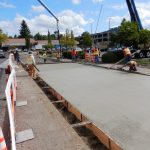It depends. The closer the pavement work is to the shopping center entrances, the more curb we would recommend replacing. For example, the curb and gutter in the top photograph should be completely replaced along with the sidewalk. Further away from the building, patching the worst sections is common. We […]
Author Archive: Thomas Zimmer
Pavement Marking: Own Your Stencils
A recent pavement preservation project initially looked great, but as the sealant wore off the aggregate, the original pavement markings showed up. You can see the striping contractor did not follow the specification to match the existing markings. The original low emissions image is about a foot larger than the new image. Unfortunately, […]
Curb Ramps: Two Common Problems, There are Others…
These photographs illustrate two common problems found on curb ramps. First, the side flares are not at a 1:10 slope. We find that it is common to see cement finishers put in ramp side slopes in a manner similar to driveway curb returns. Side slopes for curb ramps where a […]
Cars Get Stuck in These Depressions in My Parking Lot, What Causes Them?
A typical combination of thin pavement structure (combined asphalt concrete and aggregate base layers) on top of a water-saturated (often found near landscaped islands), weak, fine-grained soil (silt or clay) allows, over a long-term, the vehicle weight to push down on the pavement structure. The actual term is material creep. […]
If You Have a Life Safety Issue, Do Not Advertise It, Fix It!
On a recent property inspection, I captured this sign and sidewalk. Fortunately, it’s not on our client’s property. But seriously, the time and effort gone into having this sign fabricated and installed should have been spent on correcting the described slippery sidewalk conditions. This property owner clearly has running slope […]
Products: GAP Mastic Crack Repair
A client in Minnesota has been extolling the ease of application and performance of a crack repair product. It is GAP Mastic Crack Repair from Maxwell Products, Inc., Salt Lake City, Utah. The product appears to be a blend of soft, polymer-modified asphalt cement with small aggregate mixed in. It […]
Selecting The Right Pavement Type
Selecting a pavement surface is typically a choice between asphalt concrete or Portland cement concrete. In many parts of the country, AC is the first choice. In the South, PCC is more common. Pavement type selection has many factors: The primary factor is initial cost of installation. Local material cost […]
Pavements? What’s the Difference?
There are three pavement types: Flexible – Asphalt concrete Rigid – Portland cement concrete Interlocking pavers – Stone, brick, or blocks But there are seemingly infinite variations of each. Flexible: The black stuff is asphalt concrete (left photo), also called hot-mix asphalt concrete. In some states or regions, it is […]
Portland Cement Concrete
Portland cement concrete (PCC) is primarily a composition of Portland cement, water, rock, and sand. Portland cement is manufactured by grinding limestone, iron ore and/or fly ash into a powder and feeding into a rotary kiln at 2,700 degrees Fahrenheit. Not unlike the residue of a coal furnace, clinkers are […]
How Does Asphalt Get Made?
Producing hot mix asphalt concrete is an energy intensive process involving heating aggregate up to 435 degrees F, then mixing in asphalt cement and recycled materials. Typical recyclables are asphalt concrete removed from older pavements & garbage, asphalt shingles, plastic and glass. So, the plant site shown has a stockpile of aggregate […]









